Are you wondering what the different types of door locks are?
Look no further. I’ve created a complete list of all the lock types available on the market.
The description of each lock type contains the most essential features and level of security so that you have all the information you need to decide which type of door lock is best for you.
Let’s see them one by one.
1. Deadbolt Locks
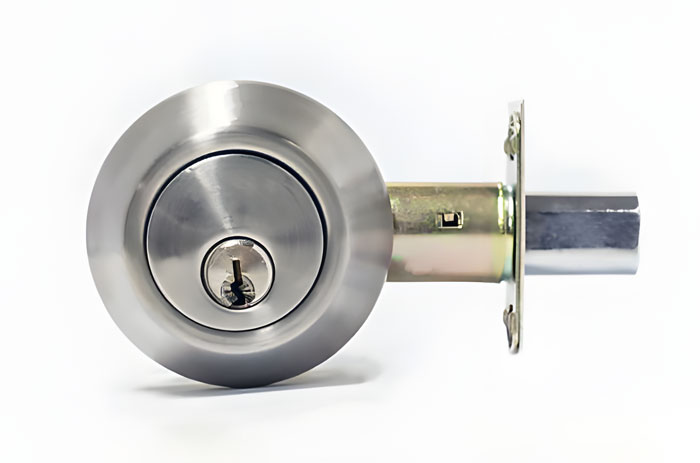
Deadbolt locks are one of the most secure types of locks. They can be locked and unlocked using either a key or a thumb turn.
When you turn the key to lock the door, the bolt extends into a mortise under the strike plate in the door frame.
Deadbolts are usually installed on exterior doors, such as front and back doors, where security is essential.
There are 2 main types of deadbolts. Single-cylinder locks have one cylinder that you can operate with a key on the outside and a thumb turn on the inside. Double-cylinder deadbolts have one cylinder on the outside and another one on the inside and both require a key.
The locking mechanism of most deadbolts is a pin tumbler lock, which is very common inside cylinder locks.
While a secure deadbolt is a critical part of home security, some models are weaker and provide less protection than others.
Not all deadbolt locks are created equal.
A simple way to decide which deadbolt is more secure is to take a look at the ANSI grade. Grade 1 locks provide the most security (this is the type I recommend), while Grade 3 models are the least secure.
While a Grade 1 deadbolt usually costs more than a standard knob lock, it can withstand higher forces, and as a consequence, it reduces the chance of burglary.
Many deadbolts come with additional features, such as bump-proof and pick-resistant technologies that further increase security.
Key takeaways:
- ANSI Grade 1 deadbolts provide superior security
- Deadbolts are a must-have on exterior doors
- You can choose from single-cylinder and double-cylinder models
- When purchasing, pick a model from a trusted manufacturer, such as Kwikset or Schlage
2. Knob Locks
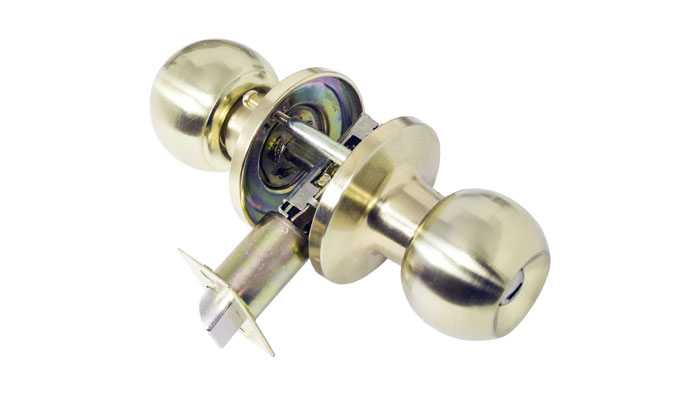
Knob locks are one of the most common lock types that you will find on most exterior doors in homes, commercial buildings, and offices. Many interior doors are also equipped with this type of lock.
To put it simply, a knob lock is a standard knob with a built-in cylinder that works with a key.
How do they work?
If the door is unlocked, you just have to turn the knob to release the spring-operated latch bolt and open the door.
When you lock the door with a key, the cylinder (the lock body) will prevent the knob from turning and the position of the bolt remains unchanged. Thus you can’t open the door.
Main advantages of knob locks:
- Low price
- Relatively easy to install and replace
- They are available in many styles and can be used with most standard doors
Their main drawback is that they provide a lower level of security compared to deadbolts. This means that a door with a single knob lock alone can be pretty easily kicked in or otherwise bypassed. As a side note, here’s how to reinforce your door to prevent kick-ins.
Key takeaways:
- A knob lock is basically a doorknob with a cylinder.
- It’s a common type of door lock
- Easy to install
- Offers a low to moderate level of security
3. Door Lever Locks
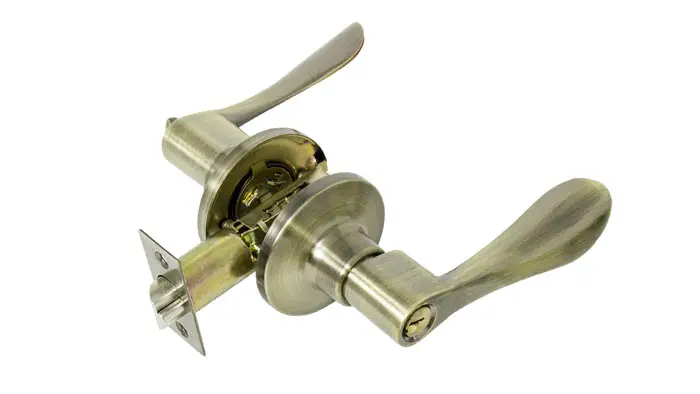
A door lever lock is similar to a knob lock except that the cylinder is not built into a knob but into a lever.
You can unlock and lock the door using the right key. When the door is unlocked, you just have to push down the lever to open it.
Door lever locksets can be fitted to both interior and exterior doors. They’re often used in residential buildings and offices. Without having any other lock installed, they offer a low to moderate level of security, such as knob locks. For entry doors, it’s best practice to use them in combination with a high-quality deadbolt.
The main benefit of a lever handle is that it’s easy to operate, even easier than a doorknob. That’s why lever locks are usually a better choice for people with certain types of mobility issues, such as arthritis.
Door lever locks are sometimes called lever handle locks, however, the latter term can also refer to a certain kind of childproof lock that’s used for safety purposes. Do not confuse these items as they’re completely different products.
Key takeaways:
- A door lever lock is a lever handle that includes a cylinder
- It’s simple to install and operate
- Can be a great choice for people with arthritis
- It comes in many styles and finishes
4. Mortise Locks

A mortise lock is a robust door lock type that’s installed in a rectangular mortise on the edge of the door. This pocket cut into the door is pretty deep and large compared to a borehole for a cylinder lock.
You can often meet these locks on doors in commercial buildings, however, mortise locks are trending for home doors as well.
Many modern mortise locks with a deadbolt are quite durable and offer a very high level of security while older models may not be as secure.
The main drawbacks of a mortise lock are the higher price and the more complicated installation process.
Key takeaways:
- A high-quality mortise lock offers superior security compared to most cylinder locks
- Installation may require an expert
- Repair is more difficult
- Costs more than a standard cylinder lock.
5. Rim Locks
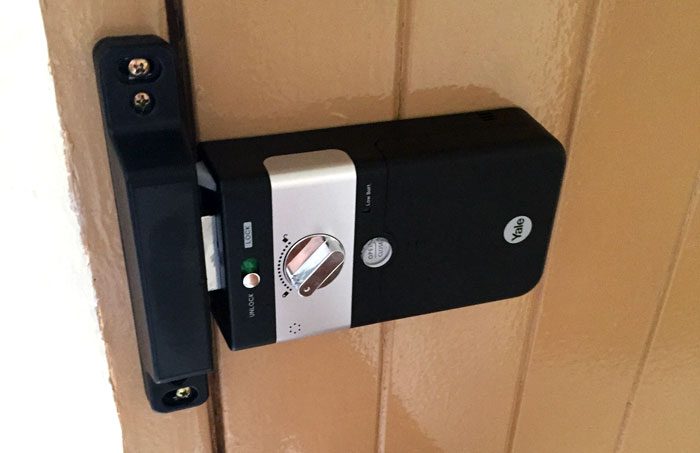
Rim locks are one of the oldest types of door locks. Instead of being installed into a mortise or borehole, they’re mounted on the surface of the door.
These simple locking devices consist of two main parts: the lock body which goes onto the door and the keeper which is mounted on the jamb. When you lock the door, the bolt extends into the keeper. Many rim locks come with an additional latch as well.
They’re affordable and easy to install as they don’t require any special tools. Regarding security, a rim lock shouldn’t be used in itself to secure an entry door because they’re relatively easy to bypass.
Key takeaways:
- Rim locks have been used for centuries
- They’re mounted on the surface of the door and jamb
- Low price
- Not recommended as a main entry door lock as they provide a relatively low level of security
6. Euro Cylinder Locks
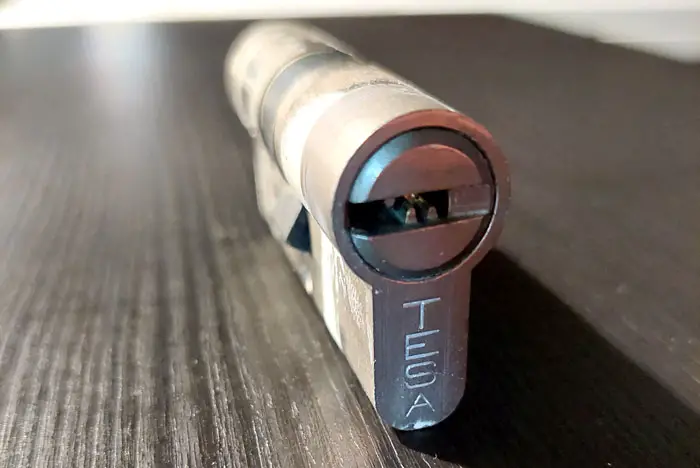
Euro cylinder locks are extremely common in Europe, but not so much in the US. They’re typically double-cylinder locks (a few models have a thumb-turn) and are mainly used on entry doors, back doors, and garage doors.
Most models have a pin tumbler locking mechanism with 5 or 6 pins inside. When the key is inserted, the interior cam can be rotated by turning the key which results in retracting or extending the bolt.
A euro profile cylinder is very easy and quick to install. In most cases, all you need is a screwdriver.
Make sure you choose a model with an anti-snap feature which means the core of the cylinder is much harder to snap in half. For additional security, consider an anti-drill and anti-bump design as well.
Key takeaways:
- Euro profiles are more common in European countries
- Quick and easy to install
- Improper installation (such as a protruding end on the outside) can pose a security risk
- Affordable
7. Smart Locks
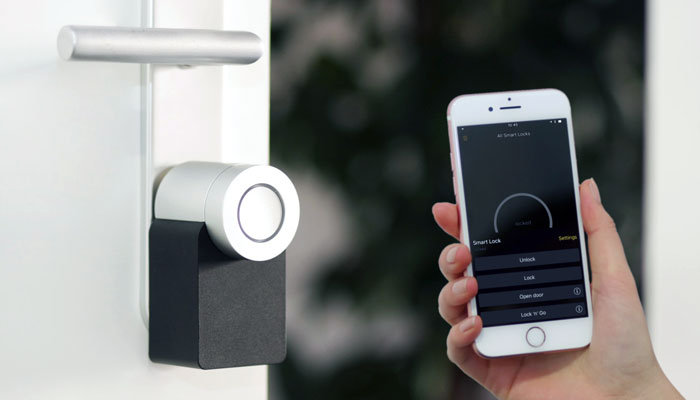
The main and distinctive feature of smart locks is that they can be connected to and controlled by a smart device, such as a smartphone. This makes the use of traditional keys unnecessary in most cases.
Most smart locks are battery-powered and use Bluetooth or Wi-Fi, and some of them are NFC-enabled. This means that you can control the locking system of your door using an app (app-controlled locks) or even your voice.
Most systems will also provide remote access to the lock, which means you can lock and unlock your door even if you’re far away from your home.
Also, you can check the status of the lock using your phone. If you’re often unsure whether you’ve locked the door or not, this feature takes the guesswork out of the process.
Pros:
- It’s convenient to use
- No key is needed to unlock the door
- You can give and restrict access easily
- Remote access
The main risk of this type of door lock is that once someone gains access to your network, they may be able to unlock your door pretty easily if you use a weak password. Also, you won’t get anywhere with this system without a Wi-Fi or Bluetooth connection.
Key takeaways:
- A smart lock allows you to lock and unlock your door using your smartphone without having to use a physical key
- It requires stable wireless and/or Bluetooth signal
- Other smart features, such as remote access, monitoring, or alerts are also often included
- These systems cost significantly more than a traditional deadbolt lock
- There’s a real risk of hacking if your network is poorly protected
8. Keypad Locks
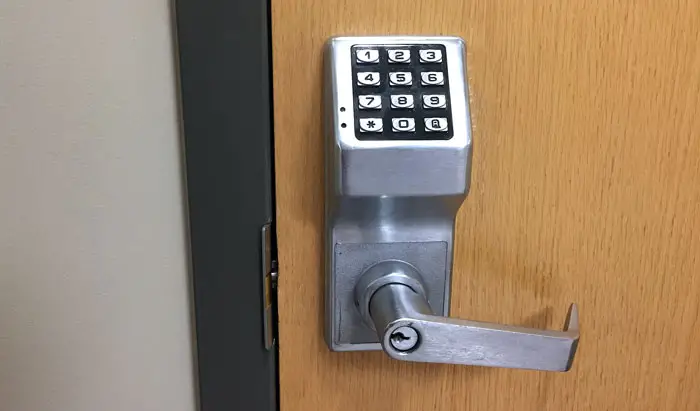
Keypad locks are a type of keyless door lock. To unlock such hardware, you need to enter a numeric code. No key is required.
Most keypad locks feature traditional buttons, however, some models come with a touchscreen.
When the right combination is entered, the locking system retracts the deadbolt and the door can be opened.
These locks are usually battery-powered, but they often can be locked and unlocked using a traditional key (backup key) too.
Mechanical pushbutton locks are very similar to keypad locks with the difference that they don’t require a power source to operate.
Advantages:
- You can leave your key at home and still unlock the door
- These are quite secure systems
- You can change the code as frequently as you want
Drawbacks:
- More complicated installation
- It requires more maintenance
- If you forget the code or the batteries die, you may find yourself in a difficult situation
Key takeaways:
- No key is required to enter your home, just a single code
- A keypad lock won’t operate without power unless it’s a mechanical pushbutton lock
- Many models can be used with a backup key
9. Biometric Door Locks
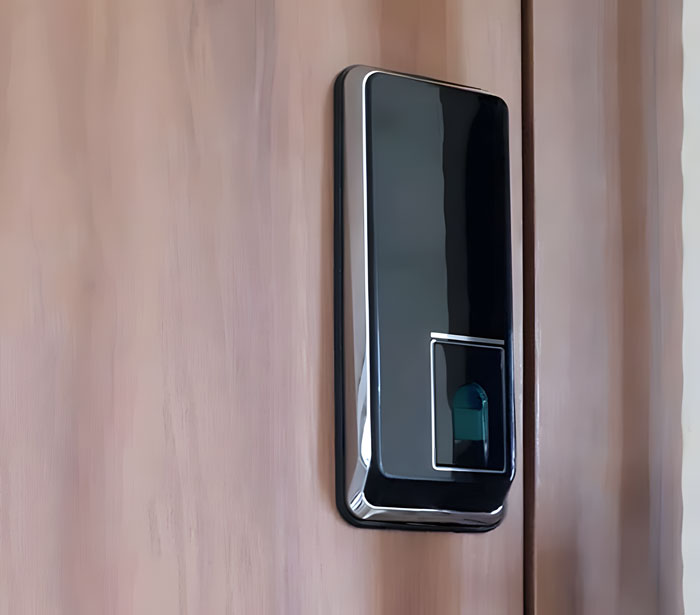
A biometric locking system unlocks a door when a pre-set unique biological identifier is presented. This identifier can be your fingerprint, face, retina, or voice.
This type of door lock is very convenient to use as you don’t need any key or card to enter your home.
Fingerprint locks are the most common type of biometric locks.
Not only is it a keyless solution, but you don’t even need to remember a code or use your smartphone to grant access. All you need is your finger, face, or voice. These are always at hand (or at face) and can’t be stolen or lost. Many models also have a keyed backup system.
A biometric lock is very difficult to override, therefore it may provide a higher level of security than a traditional lock. However, that’s not always the case. Much depends on the strength of the bolt, strike plate, and door frame. By the way, here’s what you need to do to reinforce your front door besides installing a high-quality lock.
Key takeaways:
- Any lock that uses a unique biological identifier to grant access is a biometric lock
- These locks cost more but they’re very convenient to use
- You can add new users easily
10. Door Chains
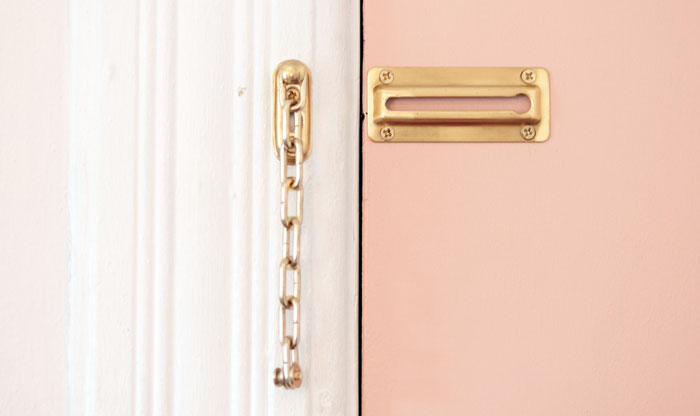
This type of door lock uses a chain to secure a door from the inside. Most door chains have two main components: the chain that’s attached to the door frame and the track that’s mounted on the surface of the door.
To secure a door, you need to slide the free end of the chain into the track. Now you can only open the door ajar from both the inside and the outside.
Door chains serve as an additional layer of security. While they allow you to quickly lock a door from the inside without a key, you can still open the door slightly without sacrificing security.
Do not rely solely on a door chain, as most models are not nearly as strong as a standard door lock and it won’t prevent force entries.
Key takeaways:
- Door chains are complementary locks which means they cannot substitute a secure door lock
- They can improve security as they allow you to open the door ajar while still preventing unauthorized entries
- They don’t require a key
- They cannot be operated from the outside
11. Swing Bar Locks
A swing bar lock is a security device that has the same function as a door chain but it usually has a more robust design.
A swing bar lock secures a door from the inside. The lock base is installed on the door while the swing bar is mounted on the jamb.
If you shut the bar, it will limit the extent to which you can open the door. Again it’s very similar to a standard door chain but in a sturdier version and without the chain.
You can use this lock on entry doors as well as on bedroom and bathroom doors for privacy purposes. Here you can read more on how to lock a bedroom door from the outside.
This lock type is inexpensive and it can be a reasonable choice for added security. However, there are some simple techniques out there that you can use to unlock it from the outside using a string without damaging the door. So never rely solely on this device.
Key takeaways:
- Swing bar locks have a more robust design than standard chain locks but they both have the same function
- Can be used as a secondary lock or privacy lock
- Cost-effective
12. Keyless Door Locks
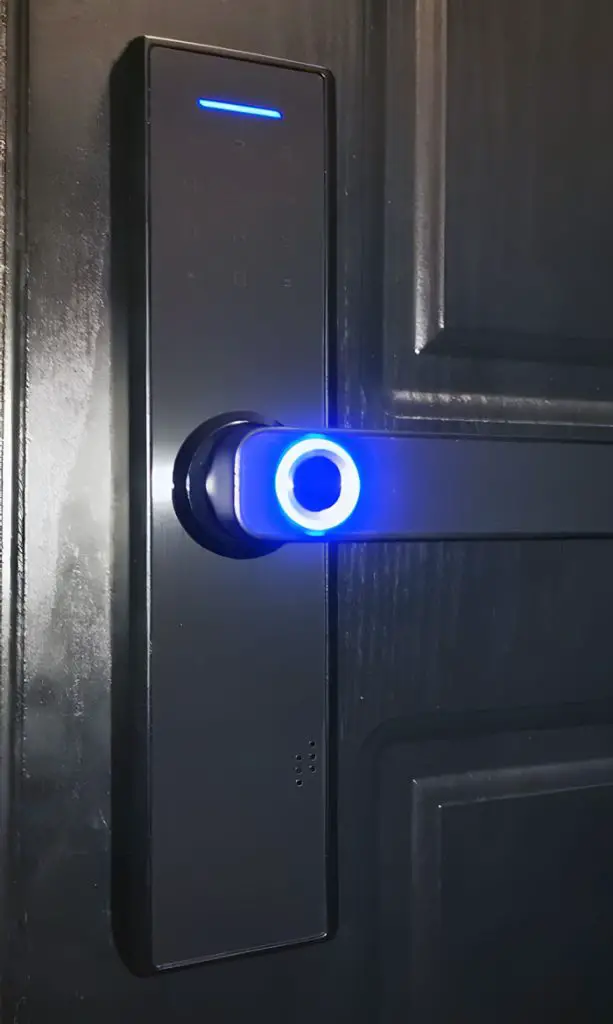
This is a large group of door locks that includes many different models. The common feature of all of these locking devices is that they don’t require a physical key.
Some of them are battery-powered, while others are simple mechanical locking devices that can only be used from the inside, such as door barricades or the model in the photo below.
Keyless door locks often feature advanced technology (such as RFID or NFC) and some kind of keypad (keypad locks) and sensors, such as fingerprint or infrared sensors. Many of them are smart locks.
The advantages and disadvantages of the actual model depend mostly on the technology it uses.
Generally speaking, keyless entry door locks are convenient to use because you can unlock your door without a key by entering a numeric code, using your finger or smartphone, or an RFID card (card reader door locks). As you can see, you can choose from many authentication methods.
Level of security: Moderate to High – much depends on the actual model
Key takeaways:
- Most of these locks use modern technology
- Usually, you need your phone, a code, a biometric identifier, or a card to lock or unlock your door
- They’re more expensive than traditional keyed door locks
13. Barrel Bolts
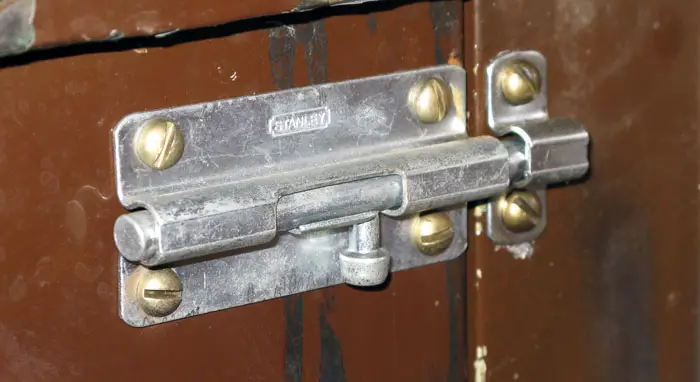
These latches are simple locking devices that consist of a catch plate and a sliding bolt.
The catch plate is attached to the door frame, while the sliding bar goes onto the surface of the door. The lock can be activated by sliding the bolt into the catch.
A barrel bolt (also known as a slide bolt) is typically used on the inside, however, certain models can be secured in a locked position using a padlock. In this case, the barrel bolt can protect a door from the outside as well.
Barrel bolts are often used on shed doors, gates, and internal doors but certain types, such as tower bolts, can also improve front door security.
A spring-loaded latch (or spring lock) is very similar in both appearance and function to a barrel bolt. The main difference is that it has an extra component, the spring. When the spring is released, the bolt extends into the corresponding hole in the door frame. Now the door is locked. To unlock it, you have to compress the spring.
Key takeaways:
- Barrel bolt latches secure a door from the inside by sliding a rod into a small hasp
- Mainly used on interior or shed doors
- Easy to install, cheap but provides a low level of security
14. Electronic Locks
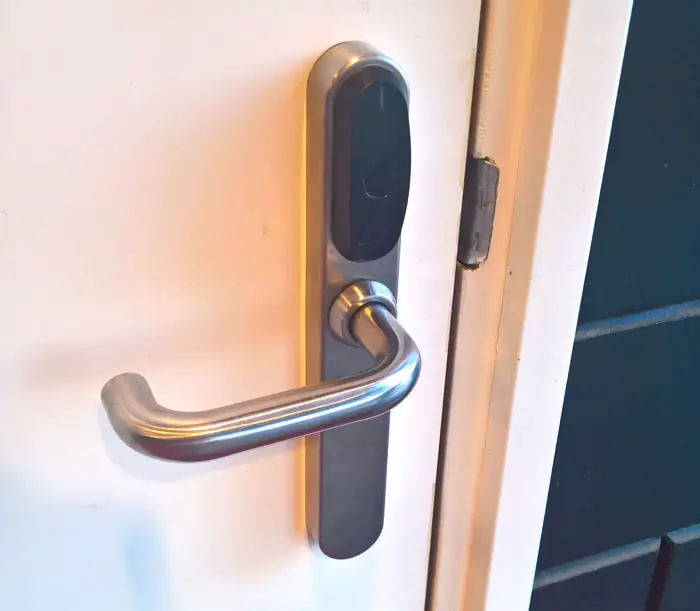
All locks that need electricity to work fall into this group. Thus smart locks, many keyless door locks, biometric locks, electric strike locks, electromagnetic locks, RFID locks, and keypad locks are all considered electronic locks.
Many of these locks have a microprocessor inside that activates a motor when the correct credential is given. You can often control them remotely.
The main benefit of electronic locks is that they can be used without a key and many of them provide a pretty high level of security.
However, if the power supply fails, you’ll need to use the backup system to lock or unlock these types of locks.
Electronic locks are typically more expensive than most other types of door locks. Also, they are usually more prone to failures than mechanical locks.
15. Sliding Door Locks
These locks are specifically designed for securing sliding doors and they’re not suitable for hinged doors.
The most common type of sliding door lock is a mortise lock. Many of these are non-keyed and can be used only from the inside. They offer a low level of security, therefore it’s highly recommended that you either upgrade them or add a secondary lock.
If you need to lock your sliding glass door from the outside, you can do that with a keyed sliding door lock or a surface-mounted hook bolt.
There are many other types of sliding glass door locks, here you will find all of them.
Tip
Sliding glass doors are quite vulnerable, and they often come with a weak lock that’s relatively easy to bypass. Therefore I suggest you consider using more than a single lock to secure your sliding door.
Level of security: it depends on the actual model you choose, however, most sliding door locks provide a low to moderate level of security
Key takeaways:
- Pre-built sliding door locks usually can be easily bypassed
- You can choose from several types of locks
- It’s best practice to add a secondary lock to your sliding door
16. Panic Bars
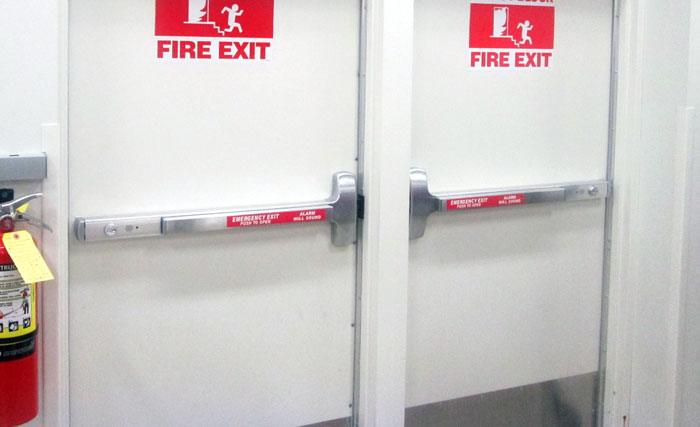
A panic bar (crash bar or panic exit device) is basically a metal bar that’s mounted horizontally on doors in public buildings, such as commercial facilities, schools, offices, churches, hospitals, etc.
A panic bar allows anyone without a key to open a door quickly by pushing the bar from the inside in case of an emergency.
Panic exit devices are mainly used on outward-opening doors. Explore more ways to secure an outswing door.
The main function and benefit of panic bars are that they allow you to quickly and easily open a door from the inside. This way people inside a building can safely leave in an emergency without losing any time trying to open the security doors.
At the same time, a panic bar secures the door so it cannot be opened from the outside, therefore unauthorized persons can’t enter the building through a security door.
Key takeaways:
- Panic bars are used on doors in public facilities
- They allow people to pass through security doors quickly in an emergency
17. Electric Strike Locks
Instead of a standard strike plate, you can use an electric strike to lock and unlock a door without a key. It’s usually a part of an access control system.
An electric strike lock is activated when it receives the correct credentials. When this happens, a metal plate (the keeper) changes position and allows the latch to retract. Now you can open the door.
When you close the door, the keeper automatically locks the latch so the door cannot be opened. Electric strikes require a power source.
Electric strike locks are either fail-safe (locks when power is applied) or fail-secure (unlocks when power is applied).
Key takeaways:
- An electric strike replaces the standard strike plate on a door frame
- It’s mainly used as a component of an access control system
- When an electric current is applied to the strike, the latch retracts (fail-secure model)
18. Thumbturn Locks
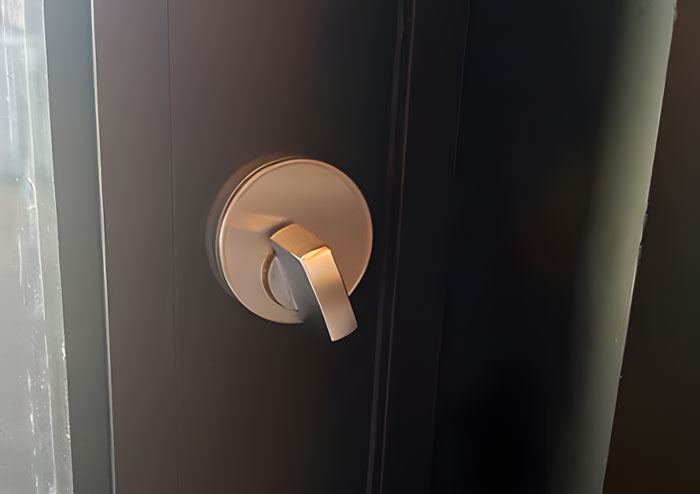
This is an umbrella term for any lock with a thumb turn.
A wide variety of locks can come with a thumb turn, including single-cylinder deadbolt locks.
Being able to unlock and lock a door from the inside using a thumb turn can have several advantages:
- Ease of use
- Keyless solution
- It allows you to quickly unlock the door in an emergency
The main disadvantage is that if you use a lock with a thumb turn on an exterior door with glass, an intruder can break the glass and have access to the thumb turn.
Level of security: depends on the locking system you use in combination with the thumb turn
Key takeaways:
- This category includes all locks that come with a thumb turn
- Thumbturn locks are easy to use which can be particularly useful in an emergency
- Use them with caution on front doors with windows
19. T-handle Locks
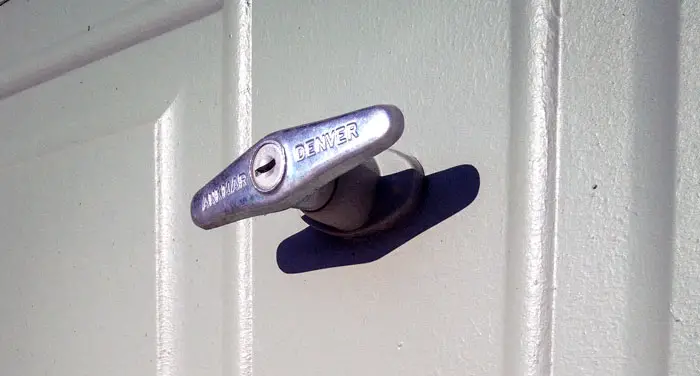
A T-handle lock is a simple device that has a built-in cylinder which is often connected to a cam. If you unlock the T-handle lock with a key and turn the handle, you can also turn the cam that’s on the shaft. This will let you open the door.
Locks with a T-shaped handle are mostly used on doors that don’t require a high level of security. For example, sheds, barns, or garage doors are sometimes equipped with this type of lock. You can also often meet a T-handle lock on vending machines, RVs, and cabinet doors.
Key takeaways:
- You can use these locks on doors that don’t require a high level of protection but not on the entry door of your home
- The handle is easy to grab
- Affordable
20. Portable Door Locks
This is a broad category with many different devices. Portable door locks come in many sizes and shapes, and the way they work may vary from product to product.
Portable door locks are often used for travel purposes, but they can improve the overall security of most doors, including entry and interior doors as well. They’re often used on apartment doors, college dorm doors, and bedrooms where no permanent lock is available. If you need to lock a door without a lock, here are your options.
Advantages:
- A portable lock does not require any tools for installation
- Can be quickly installed and removed without any permanent modification
- Most models can be easily carried in a travel bag
Disadvantages:
- They don’t provide outstanding security
- Compatibility issues may arise
Key takeaways:
- They can be installed without any drilling or screwing
- Great for traveling
- Easy way to add extra security
- Correct installation is key
- Do not rely heavily on these types of door locks
21. Padlocks

Padlocks are a type of portable lock that has been around for centuries. A typical padlock has two main parts, the body and the shackle (usually a U-shaped loop).
To use a padlock to lock a door, you have to insert the shackle through a hasp or other opening. The actual locking mechanism may vary from model to model.
Traditional padlocks work with either a key or a combination. Smart padlocks also exist which can be controlled using a smartphone, and some of them come with a built-in fingerprint sensor.
Padlocks are typically used on structures without a permanent locking system, such as storage units, sheds, lockers, or construction sites to prevent unauthorized entries.
The main benefit of a padlock is portability and easy installation.
Key takeaways:
- Padlocks are portable locks that can be used to secure structures without a permanent lock
- High-end models offer a reasonable level of security, however, some of them can be pretty vulnerable to tampering
22. Magnetic Locks
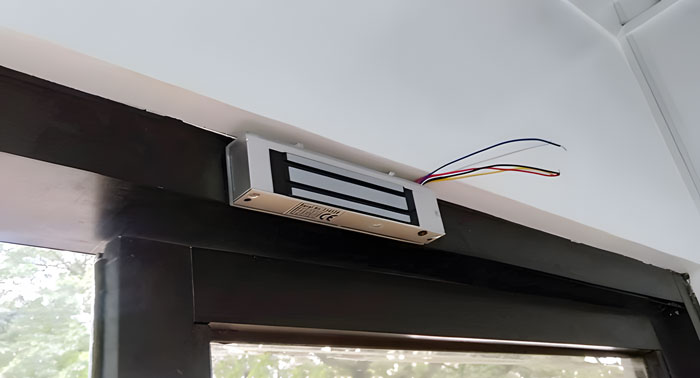
A magnetic lock is an electric door lock that keeps a door in a locked position using an electromagnet.
This door lock type has two main components: the armature plate and the electromagnet.
In most cases, you have to install the armature plate on the door and the magnet on the door frame.
Once you activate the electromagnet, it creates a magnetic field that will keep the door closed.
Electromagnetic locks are fail-safe devices which means they need a power supply to remain in a locked position otherwise the door will be unlocked.
This type of lock can be pretty secure, however much depends on their holding force. I recommend that you use a mag lock that has at least 1,000 pounds of holding force (more if you need a higher level of security).
From a security standpoint, the main disadvantage of magnetic locks is that the door automatically unlocks once the power supply fails. Regarding safety, this is a benefit as people will be able to leave the facility without difficulty in the event of an emergency.
Key takeaways:
- Mag locks work by creating a magnetic field that holds the door in a closed position
- They’re fail-safe locks, so they require electricity to keep the door locked
- Good-quality mag locks are expensive
23. Childproof Locks
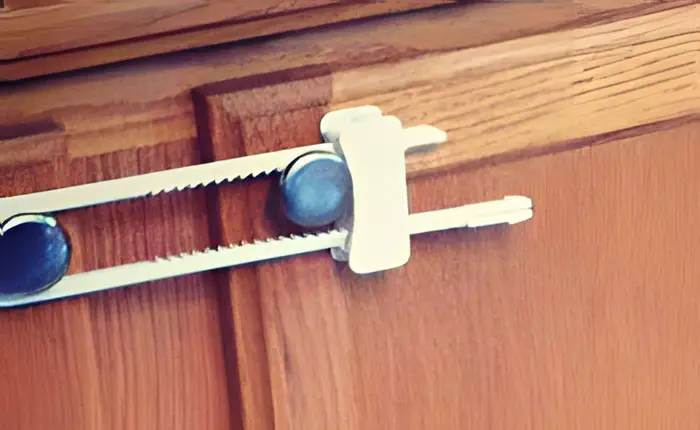
Childproof locks are available for all types of doors, including interior and exterior doors, cabinet doors, drawers, oven doors, and refrigerator doors.
These simple locks are designed to improve safety by preventing children from opening doors or accessing certain areas of the house.
Therefore childproof locks are primarily used in households with small children to prevent unnecessary injuries and accidents. The vast majority of these locks are not suitable for security purposes.
Key takeaways:
- Childproof locks are used to restrict the access of children to certain areas of the house
- They’re not designed to stop intruders
24. Night Latches
A night latch is mounted on the interior surface of an exterior door. It usually allows you to lock and unlock your door with a thumb turn from the inside. However, you don’t have access to the lock from the exterior side of the door (non-deadlocking night latch).
Most night latches are rim locks, and some of them can also be operated by using a key from the outside (deadlocking night latches).
This hardware is mainly used as a secondary lock.
Key takeaways:
- Night latches are secondary door locks (usually rim locks) that are fitted to the interior side of a door
- Easy to install and operate
- High-security models offer more protection
25. Cam Locks
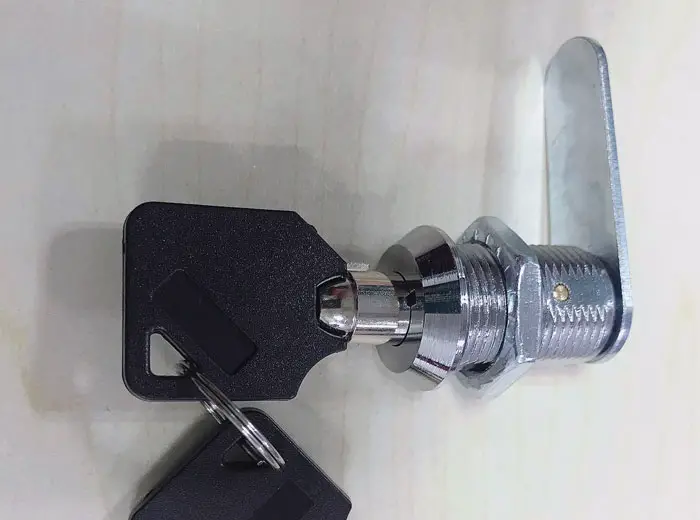
These simple L-shaped locks are mainly used to secure drawers, mailboxes, gates, storage lockers, cabinets, and other pieces of furniture.
A cam lock has two main components: a cylinder and a cam which is also known as a tongue. The cam can be straight, hooked, bent, or offset. Most cam locks require a key.
These types of locking devices are affordable and they provide a basic level of security, however, they don’t withstand force attacks.
Key takeaways:
- Cam locks are often used to lock cabinets and other furniture
- They have a simple design with a keyed cylinder
Photos: DailyHomeSafety, Wikimedia (Mirrorsnake, Khrystinasnell, Wesha, Donald Trung), Flickr (Kai Hendry, Random Retail, Dave Dugdale)

















